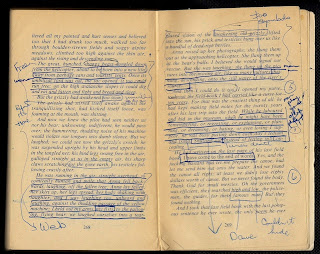The Four Stragglers
Frank L. Packard
Toronto: Copp Clark, 1923
It's hard to know just what to expect when picking up a Packard; reference books offer little or nothing, archived reviews are few, and with
one or
two or
three exceptions book bloggers have given him a pass. Add to all this the sad fact that the dust jackets to his books are almost always missing, as is the case with this soiled, stained, beat-up copy I spotted last October in the "FREE" box at Montreal's
Cheap Thrills.
A few pages into this free book, I was beginning to think that it might just end up being my favourite Packard novel. Although that first flush of excitement gave way to disappointment, I don't regret the read.
The Four Stragglers opens in the darkness of an unnamed battlefield during the Great War. Cut off from their respective units, three soldiers take refuge in a thicket; a fourth lies dead or unconscious a few metres away. Flares flying above reveal faces, and the cognizant come to recognize that they'd all played parts in a daring jewel heist not two years earlier.
It's a confusing, chaotic scene. Shouldn't it be? Shells rain down, a munitions dump explodes in the distance and somewhere out there march Germans with bayonets. Then there's that fourth straggler lying on the ground. The idea that he might be listening in on the reunion forces cryptic conversation. Eventually, one of the other three raises his rifle and fires:
The first man screamed out:
"Christ! What have you done?"
"I think he was done in anyway... It was as well to make sure."
Dead. Dead. And yet the next flare that hangs in the heavens reveals that his body has disappeared.
We're transported suddenly to the Claremont, an exclusive gentleman's club in London's West End. The Armistice now more than three years in the past, the reader is listening in on a conversation between Sir Harris Graves and Captain Francis Newcombe. A man of obvious privilege, Sir Harris has the means and the time to pursue criminology as a sort of hobby. His current focus is the aforementioned theft and its connection with an elusive, infamous East End criminal known as Shadow Varne. The captain, transfixed, expresses concern:
"I fell impelled to say to you that, if this man is what you describe him to be, is so dangerous as you say he is, I would advise you, Sir Harris, in all seriousness to leave him – to Scotland Yard."
Sir Harris stands fast... and is murdered before morning. If it hasn't already, the reader's suspicion will fall on Newcombe, who is not only revealed to be the straggler who shot the injured soldier, but Shadow Varne himself.
I found the most interesting aspect of
The Four Stragglers revolved around the idea of the T.G. – the Temporary Gentleman – a man who through obtaining commission would be permitted privileges heretofore enjoyed only by members of a certain class. For Varne, as Captain Francis Newcombe, lasting entry to a once closed-off world is made possible through wartime heroics. "I became a Permanent Gentleman", he tells doomed Sir Harris. "Democracy! Private Francis Newcombe – Captain Francis Newcombe – Francis Newcombe, Esquire."
Packard's novels are always peppered with the fantastic and improbable; for much of
The Four Stragglers I took Newcombe's rise as another example. But then I thought of our own Sir Arthur Currie, GCMG, KCB, a man who himself rose from the lowest ranks. I don't mean for a second to suggest that Currie was a murderer – just an embezzler.
Object: The first Canadian edition, my copy appears to have been first owned by a man named Donald Shipley. A 1925 Christmas gift from "Claude", it bears the label of Wendell Holmes, a bookseller in London, Ontario.
Access: Canadians, look to your universities – of the public libraries, only Toronto's serves.
The Canadian first shares plates with the Doran American first and a later Burt reprint. It wasn't until 1934 that the Hodder & Stoughton British first appeared. Together, more than couple of dozen copies are listed for sale online. They begin at £4.00, but the one to buy is a $15 copy of the Canadian first with dust jacket by A.D. Rahn. The most expensive – forty dollars – comes from an ill-informed bookseller who writes: "THIS A 1923 HARDCOVER BOOK IT IS EXTREMLY [
sic] RARE BOOK IT HAS A NAME INSIE [
sic] THE COVER AND HAS BEEN READ THE BINDING IS SUNNED AND HAS NO JACKET THE CORNERS ARE BUMPED AND THE PAGES ARE TANNED EVENLY."
Čtyři zaběhlíci, a Czech edition, was published in 1928. Apparently the National Library of the Czech Republic has a copy.




























